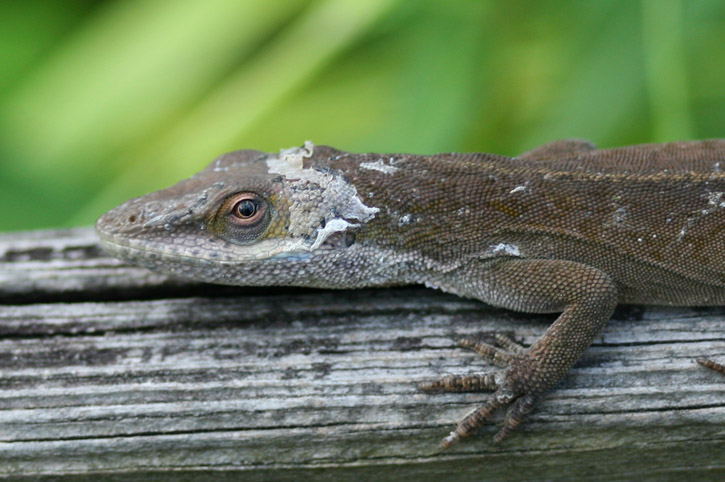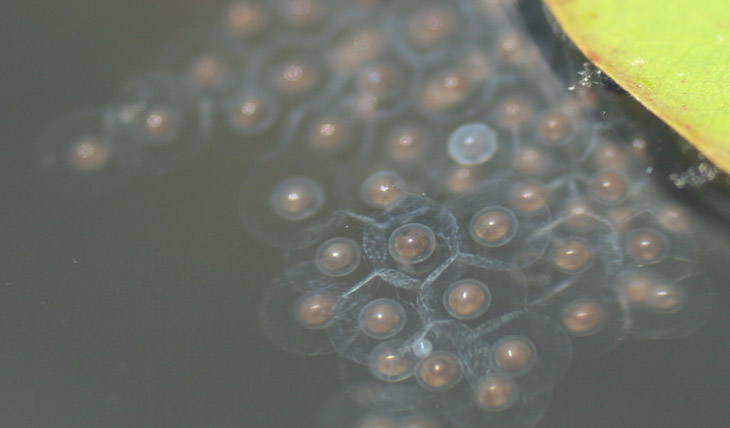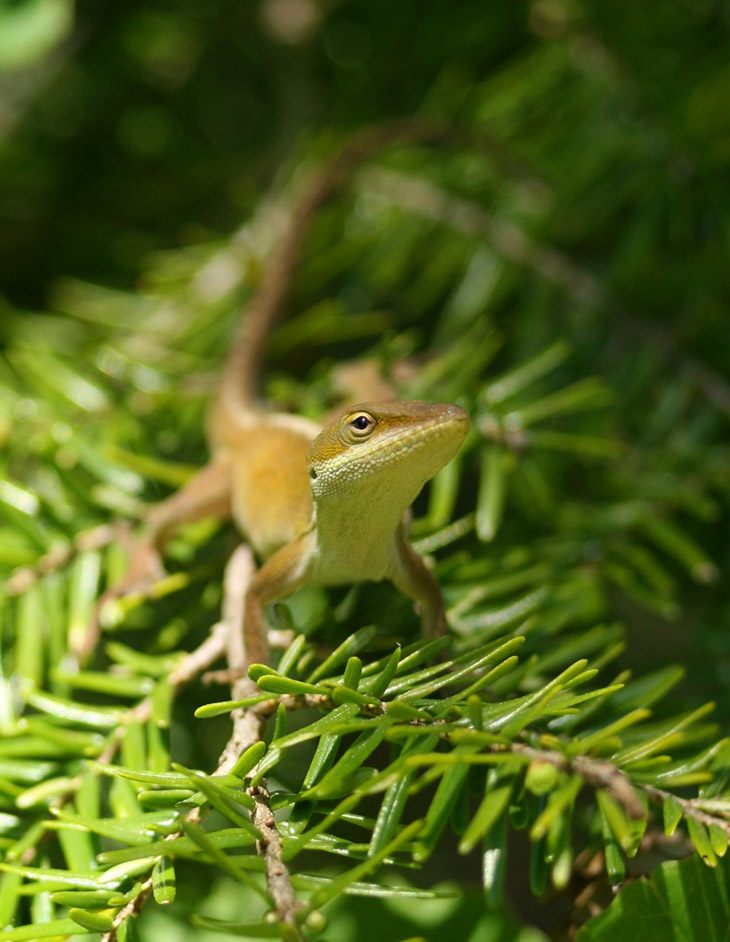Because you know we’ll be back to the arthropods soon enough…
All of these, by the way, came from the NC Botanical Gardens, just not on the same day. There are reptiles and amphibians to be found elsewhere of course, but the conditions in the gardens are pretty welcoming to them, and they have enough human contact to be less shy than normal.

On a fence where they’re frequently seen, two green anoles (Anolis carolinensis) were hanging out in reasonably close proximity. Yes, of course this is green – get your eyes checked. Actually, this dark hue is usually an indication of either a sexual or territorial display, more often aggressive – when the males are showing off for the wimminfoke, it’s usually with bright green colors and by flaring their dewlap, a fan under their throats that is brilliant pinkish-purple in hue. The pasty appearance of this one is due to molting; unlike snakes, most lizards shed their skin in patches and flakes, and at times it produces a very tattered effect.
 One of the two resident common snapping turtles (Chelydra serpentina) was peeking out of the water while I was around, one of the very few times I’ve seen this – their shyness is way out of proportion to their reputation and even just their appearance, but the ‘expression’ in this particular image is up for interpretation; I can see a lot of different possibilities, and I’m betting you could too if I were to merely suggest them to you, but I’d rather you take a good look on your own without the impressions. I liked the faintly eye-bending effect of the water’s distortion, where the portions above the surface look normal but everything below gets shifted in perspective and reshapes the turtle’s head – for a more natural view see here (and Mr. Bugg still hasn’t sent me my photos.)
One of the two resident common snapping turtles (Chelydra serpentina) was peeking out of the water while I was around, one of the very few times I’ve seen this – their shyness is way out of proportion to their reputation and even just their appearance, but the ‘expression’ in this particular image is up for interpretation; I can see a lot of different possibilities, and I’m betting you could too if I were to merely suggest them to you, but I’d rather you take a good look on your own without the impressions. I liked the faintly eye-bending effect of the water’s distortion, where the portions above the surface look normal but everything below gets shifted in perspective and reshapes the turtle’s head – for a more natural view see here (and Mr. Bugg still hasn’t sent me my photos.)
 In contrast to the startled appearance of the anole at top, this American five-lined skink (Plestiodon fasciatus) watched us creeping closer with little apparent concern, at times seeming to drift off into slumber. Eventually, we got close enough that it figured concealment was called for and it slipped into a crack in the rock sculpture that you see here, but not before we got a fine selection of images. It’s all about going slow, and getting the shots you can before you try to get closer. Not everything that you get is going to be a keeper, but it’s better to get an okay shot from a short distance than to try and get close enough for the best pics and scare the subject away instead, ending up with nothing at all.
In contrast to the startled appearance of the anole at top, this American five-lined skink (Plestiodon fasciatus) watched us creeping closer with little apparent concern, at times seeming to drift off into slumber. Eventually, we got close enough that it figured concealment was called for and it slipped into a crack in the rock sculpture that you see here, but not before we got a fine selection of images. It’s all about going slow, and getting the shots you can before you try to get closer. Not everything that you get is going to be a keeper, but it’s better to get an okay shot from a short distance than to try and get close enough for the best pics and scare the subject away instead, ending up with nothing at all.
 While the skink was drifting off, this one was almost certainly well beyond that point. This red-bellied water snake (Nerodia erythrogaster) was sitting in plain sight right alongside the raised walkway, never even twitching as we leaned in close. Even with frequent exposure to humans, I find it hard to believe the snake was that conditioned to close approaches, but here’s the crucial factor: snakes have no eyelids. Basking as it was in a patch of bright sunlight, this one most likely was fast asleep, and our slow approach without throwing a shadow across its face wasn’t enough to trigger any protective response. Add in the raised walkway we were on the entire time, preventing us from producing any vibrations that the snake could feel (they don’t have ears, either,) and you get a distinct possibility that the snake was deep in Dreamland, or whatever passes for such with a snake (Carl Sagan’s book The Dragons of Eden gives some interesting speculations about how reptile brains actually work, if you have the interest – dreaming seems relatively unlikely.)
While the skink was drifting off, this one was almost certainly well beyond that point. This red-bellied water snake (Nerodia erythrogaster) was sitting in plain sight right alongside the raised walkway, never even twitching as we leaned in close. Even with frequent exposure to humans, I find it hard to believe the snake was that conditioned to close approaches, but here’s the crucial factor: snakes have no eyelids. Basking as it was in a patch of bright sunlight, this one most likely was fast asleep, and our slow approach without throwing a shadow across its face wasn’t enough to trigger any protective response. Add in the raised walkway we were on the entire time, preventing us from producing any vibrations that the snake could feel (they don’t have ears, either,) and you get a distinct possibility that the snake was deep in Dreamland, or whatever passes for such with a snake (Carl Sagan’s book The Dragons of Eden gives some interesting speculations about how reptile brains actually work, if you have the interest – dreaming seems relatively unlikely.)
I’m fairly certain I’ve spotted this individual once before in the garden, but didn’t identify it then because they’re pretty rare in this area, at least in my experience – mostly it’s the queen snakes and northern water snakes. Back when I lived near the mouth of the Neuse River and visited frequently, I think I saw the juveniles from time to time, but never an adult. They don’t get quite the size/girth of the northern water snakes, but they average over a meter in length and perhaps a little more than 3 cm in girth – so, shorter but slightly thicker than the black rat snakes. In other words, big enough for those that fear snakes to react sharply, despite their harmlessness.

I had to throw in these eggs, likely from some unknown (to me anyway) species of frog – I just liked the way the light worked on them, especially highlighting the borders where individual eggs were sticking together. I’ll try to keep checking back and see what develops from them.
But in closing, we’ll have to return to the anoles. I mentioned the dark coloration at the beginning of the post, and it was spotting another such anole sitting atop a fencepost that helped me find this one – the dark color told me another was likely in the area, and an incautious movement on its own part let me zero in. At that point it was consuming a caterpillar, but on my next pass around the paths it provided a nice, alert pose that seems rather unanolelike (given that anole is pronounced, “a-noley,” saying that word aloud is guaranteed to defy comprehension from anyone except a herpetology enthusiast.) Patience and timing allowed me to capture both the pose and the light hitting its eye, and I’m pleased with the image, but I’ll let you consider what it puts you in mind of the most.





















































